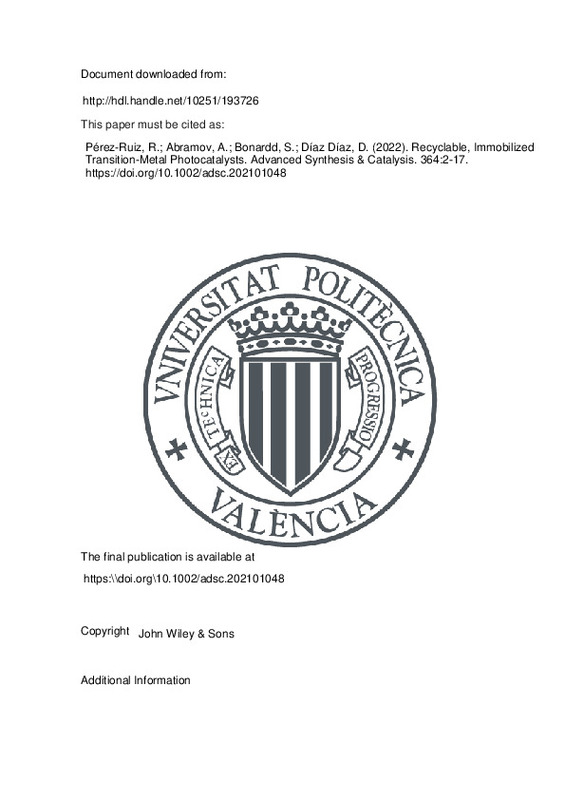JavaScript is disabled for your browser. Some features of this site may not work without it.
Buscar en RiuNet
Listar
Mi cuenta
Estadísticas
Ayuda RiuNet
Admin. UPV
Recyclable, Immobilized Transition-Metal Photocatalysts
Mostrar el registro sencillo del ítem
Ficheros en el ítem
| dc.contributor.author | Pérez-Ruiz, Raúl
|
es_ES |
| dc.contributor.author | Abramov, Alex
|
es_ES |
| dc.contributor.author | Bonardd, Sebastian
|
es_ES |
| dc.contributor.author | Díaz Díaz, David
|
es_ES |
| dc.date.accessioned | 2023-05-29T18:03:04Z | |
| dc.date.available | 2023-05-29T18:03:04Z | |
| dc.date.issued | 2022-01-04 | es_ES |
| dc.identifier.issn | 1615-4150 | es_ES |
| dc.identifier.uri | http://hdl.handle.net/10251/193726 | |
| dc.description.abstract | [EN] The use of transition-metal complexes as photocatalysts have allowed the performance of diverse organic transformations in an outstanding manner, characterized not only by high yields, TOF, and selectivity values, but also by modulating and providing access to novel molecular structures that, without them, would be difficult if not impossible. However, one of the biggest concerns regarding the use of these photocatalysts relies on the difficulties associated with their isolation from reaction media and reutilization once the chemical process ends. The above, besides contaminating reaction products and requiring out tedious purification processes, prompts the inevitable loss of the catalyst, directly affecting its recyclability. In addition, this situation results in negative outcomes from an economic and environmental perspective, since transition-metal complexes are usually expensive materials, and their unsuccessful recovery could result in leakage into the environment. These drawbacks served as inspiration for the elaboration of the present review focused on the development of novel strategies developed during the last decade for the successful recovery of these species. The strategies summarized herein, whether for homogeneous or heterogeneous systems, are based on the use of thermotropic solvents, changes in the hydrophilic balance of the catalyst, the employment of polymers, copolymers, porous macromolecular structures, and inorganic nanostructures as support of these entities. Moreover, the use of organized and confining media, such as micelles and gels in this context, is also discussed. We hope that this review will motivate the search for new strategies to develop novel catalytic systems, understanding that high performance is based not only on yields but also on recyclability, sustainability, and responsibility to the environment. | es_ES |
| dc.description.sponsorship | Financial support from the Universitat Regensburg, the Elitenetzwerk Bayern (SYNCAT), the Spanish Ministry of Science and Innovation (PID2019-105391GB-C21, PID2019-105391GB-C22), is gratefully acknowledged. S.B. thanks MINECO for a Juan de la Cierva-Formacion contract (FJC2019-039515-I). R. P.-R. thanks Generalitat Valenciana for a Distinguished Researcher contract (CIDEGENT/2018/044). D.D.D. thanks the DFG for the Heisenberg Professorship Award and the Spanish Ministry of Science, Innovation and Universities for the Senior Beatriz Galindo Award (Distinguished Researcher, BEAGAL18/00166). D.D.D. also thanks NANOtec, INTech, Cabildo de Tenerife and ULL for laboratory facilities. | es_ES |
| dc.language | Inglés | es_ES |
| dc.publisher | John Wiley & Sons | es_ES |
| dc.relation.ispartof | Advanced Synthesis & Catalysis | es_ES |
| dc.rights | Reserva de todos los derechos | es_ES |
| dc.subject.classification | QUIMICA ORGANICA | es_ES |
| dc.title | Recyclable, Immobilized Transition-Metal Photocatalysts | es_ES |
| dc.type | Artículo | es_ES |
| dc.identifier.doi | 10.1002/adsc.202101048 | es_ES |
| dc.relation.projectID | info:eu-repo/grantAgreement/AEI/Plan Estatal de Investigación Científica y Técnica y de Innovación 2017-2020/PID2019-105391GB-C21/ES/DESARROLLO DE FORMULACIONES A BASE DE GEL PARA CATALISIS REDOX BASADA EN ANIQUILACION TRIPLETE-TRIPLETE USANDO LUZ VISIBLE/ | es_ES |
| dc.relation.projectID | info:eu-repo/grantAgreement/GENERALITAT VALENCIANA//CIDEGENT%2F2018%2F044//PHOTON UPCONVERSION REDOX CATALYSIS/ | es_ES |
| dc.relation.projectID | info:eu-repo/grantAgreement/AEI/Plan Estatal de Investigación Científica y Técnica y de Innovación 2017-2020/PID2019-105391GB-C22/ES/DESARROLLO DE NUEVOS SISTEMAS DE CONVERSION BIFOTONICA A MAYOR FRECUENCIA BASADOS EN ANIQUILACION TRIPLETE-TRIPLETE PARA FOTOCATALISIS REDOX CON LUZ VISIBLE/ | es_ES |
| dc.relation.projectID | info:eu-repo/grantAgreement/MCIU//BEAGAL18%2F00166/ | es_ES |
| dc.relation.projectID | info:eu-repo/grantAgreement/MINECO//FJC2019-039515-I/ | es_ES |
| dc.rights.accessRights | Abierto | es_ES |
| dc.contributor.affiliation | Universitat Politècnica de València. Escuela Técnica Superior de Ingenieros Industriales - Escola Tècnica Superior d'Enginyers Industrials | es_ES |
| dc.description.bibliographicCitation | Pérez-Ruiz, R.; Abramov, A.; Bonardd, S.; Díaz Díaz, D. (2022). Recyclable, Immobilized Transition-Metal Photocatalysts. Advanced Synthesis & Catalysis. 364:2-17. https://doi.org/10.1002/adsc.202101048 | es_ES |
| dc.description.accrualMethod | S | es_ES |
| dc.relation.publisherversion | https:\\doi.org\10.1002/adsc.202101048 | es_ES |
| dc.description.upvformatpinicio | 2 | es_ES |
| dc.description.upvformatpfin | 17 | es_ES |
| dc.type.version | info:eu-repo/semantics/publishedVersion | es_ES |
| dc.description.volume | 364 | es_ES |
| dc.relation.pasarela | S\448469 | es_ES |
| dc.contributor.funder | Elitenetzwerk Bayern | es_ES |
| dc.contributor.funder | GENERALITAT VALENCIANA | es_ES |
| dc.contributor.funder | Universität Regensburg | es_ES |
| dc.contributor.funder | Deutsche Forschungsgemeinschaft | es_ES |
| dc.contributor.funder | Agencia Estatal de Investigación | es_ES |
| dc.contributor.funder | Ministerio de Economía y Competitividad | es_ES |
| dc.contributor.funder | Ministerio de Ciencia, Innovación y Universidades | es_ES |








